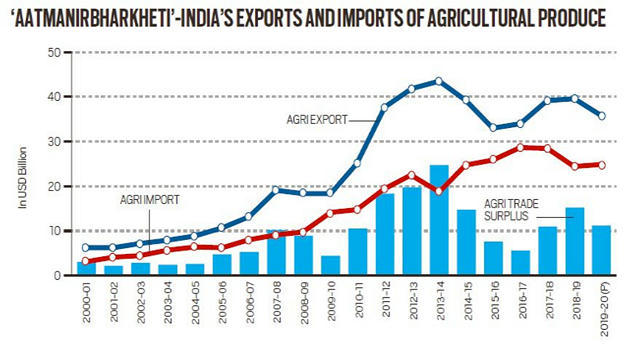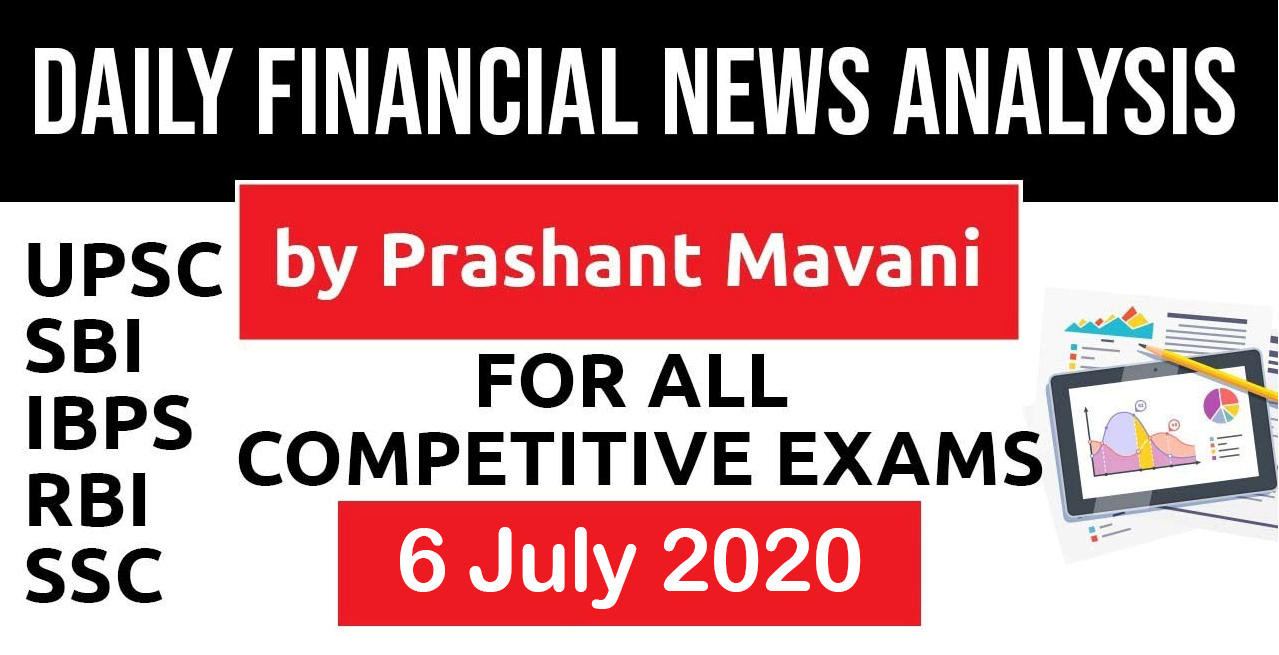Table of Contents
Aatmanirbharta of agriculture
- We have a population of 1.37 billion.
- We have to produce most of our food at home.
- Mid-1960s we used to be in a “ship to mouth” situation
- There is a political price we have to pay for over-dependence on food aid.
- In last 10 years, India has been a net exporter of agri-produce.
- 2013-14 was a golden year for agri-trade: exports peaked at $43.6 billion while imports were $18.9 billion, giving a net trade surplus of $24.7 billion.

- Agri-exports have been sluggish and sliding
- 2014-2019: agri-exports were just $36 billion, and the net agri-trade surplus at $11.2 billion.
- Judging by the above given figures, it looks like doubling agri-exports by 2022 is almost impossible.
- We need to keep in mind the principle of “comparative advantage”.
Agri-export basket of 2019-20
- Marine products $6.7 billion
- Rice $6.4 billion
- Spices $3.6 billion
- Buffalo Meat $3.2 billion
- Sugar $2.0 billion
- Tea-Coffee $1.5 billion
- Fruit-Veg $1.4 billion
- Cotton $1.0 billion
- Rice and sugar are subsidised through free power and fertilisers.
- Per hectar basis, total 10-15% of the value of rice and sugar produced, is subsidised.
- Virtual export of water
- One kg of rice requires 3,500-5,000 litres of water
- One kg of sugar consumes about 2,000 litres of water
- Almost 75% of the nitrogen in urea is not absorbed by plants.
- Why don’t we offer similar incentives for exports of high-value agri-produce?
- Agri-imports front, the biggest item is edible oils worth about $10 billion.
- This is where there is a need to create “aatma nirbharta”.
- Create competitive advantage
- Augmenting productivity and increasing the recovery ratio of oil from oilseeds.
- While mustard, sunflower, groundnuts, and cottonseed have a potential to increase oil output to some extent, the maximum potential lies in oil palm.
- OIL PALM is the only plant that can give about four tonnes of oil on a per hectare basis.
- India has about 2 million hectares that are suitable for oil palm cultivation — this can yield 8 mt of palm oil.
- But it needs a long term vision and strategy.
14 INDICATORS
- Economic Affairs Secretary Tarun Bajaj: “We are monitoring 14 parameters on a weekly basis to see the change”
- Contraction has come down.
- E-way bills, GST collections and exports were on the rebound
- Government is looking to road and railway projects, which can have a spin-off effect, to play a key role in revival.
- NHAI plans to attract Rs 50k crore via SPV.
- Railway privatisation (trains) and station redevelopment.
- Govt. has already cleared 70 projects worth ₹8,000 crore under SWAMIH (Special Window for Affordable and Mid-Income Housing).
- SWAMIH will provide last-mile funds for stalled housing projects.
- The government will exit non-strategic sectors.
- Credit bguarantee scheme for MSMEs
- Reforms in sale of farm produce
‘Governance in commercial banks in India’
- The recent RBI discussion paper.
- It seeks to bring about path-breaking reform in private sector, nationalised and regional banks.
- It proposed board-led oversight and evaluation structures for compliance, risk-taking, internal audit and vigilance, so as to proactively boost governance standards in Indian banking.
- The balance of power between the board and the chief executive officer (CEO) will shift in favour of the former.
- Selection of board members and their compensation.
- Board of directors of a bank comprise not less than six directors and not more than 15, with independent director accounting for a majority.
- Chief risk officer and chief compliance office report to the risk management committee of the board.
- Head of internal audit and the chief of internal vigilance would perform under supervision of the audit committee of the board.
- And both the risk committee and the audit committee of the board would consist of only non-executive directors (NEDs).
- Further, a nomination and remuneration committee of the board is also proposed, and which again would be made up of only NEDs.
- And the performance of the NEDs would be evaluated by the entire board, minus the concerned NED.
- Surely, there’s a solid case for an outside agency to monitor board performance as well.
- The regulation of bank bonuses by RBI seems to be a work in progress.
- Discussion of bank governance reform would be incomplete without discussion of banking supervision reform, on which there is little clarity.
Download Free PDF






















 WhatsApp
WhatsApp